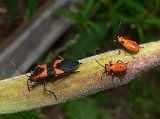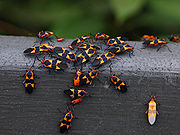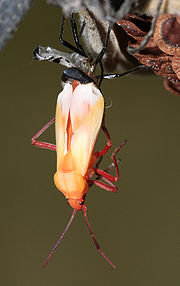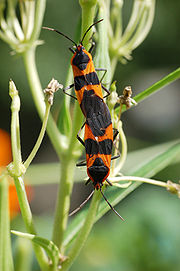
Oncopeltus fasciatus
Encyclopedia
The milkweed bug, Oncopeltus fasciatus, is a medium–sized hemiptera
n (true bug) of the family Lygaeidae. It feeds mainly on grains, particularly those of the milkweed. Like all hemiptera
, it feeds through a long mouthpart
known as a rostrum
. O. fasciatus is commonly used in science due to ease of rearing and ease of dissection.
 The large milkweed bug adult is a 9–18 mm long insect. Mature adults are orange with black rhomboidal spots at both end of a body and a black band in the middle. Freshly molted individuals are pale yellow with gray spots that change into black with time. Bright orange instar
The large milkweed bug adult is a 9–18 mm long insect. Mature adults are orange with black rhomboidal spots at both end of a body and a black band in the middle. Freshly molted individuals are pale yellow with gray spots that change into black with time. Bright orange instar
s resemble adults, with orange-black pattern different than in grown individual and without wings. However, wingpads are visible and become more pronounced with each molt. Adult females have several black spots on rear part of their abdomen, while males have only one.
. It is found as far north as Ontario, Canada, but is more abundant in south-eastern United States. Groups of insects in all stages of development are commonly found between May and October on common milkweed
plants.
 Adults that survived winter mate in May-June, when common milkweed plants have grown enough to provide shelter. During mating, female and male may become connected for up to 10 hours. Eggs are laid on seed pods or under a leaf. Average female lays 30 pale orange eggs in a day, in several batches during summer. Eggs change color, becoming more intensely orange toward hatching. This insect undergoes incomplete metamorphosis. Nymphs hatch after about 1 week and molt 5 times before becoming adults.
Adults that survived winter mate in May-June, when common milkweed plants have grown enough to provide shelter. During mating, female and male may become connected for up to 10 hours. Eggs are laid on seed pods or under a leaf. Average female lays 30 pale orange eggs in a day, in several batches during summer. Eggs change color, becoming more intensely orange toward hatching. This insect undergoes incomplete metamorphosis. Nymphs hatch after about 1 week and molt 5 times before becoming adults.
 Adults and nymphs feed on milkweed plant juices, seeds and occasionally on other plant juices. When their native plant is scarce, they may become scavengers and predators. Both nymphs and adults use milkweed as their primary source of food.
Adults and nymphs feed on milkweed plant juices, seeds and occasionally on other plant juices. When their native plant is scarce, they may become scavengers and predators. Both nymphs and adults use milkweed as their primary source of food.
After feeding on milkweed plant or seeds, the insects accumulate toxic glycoside
s in their bodies. This, combined with warning orange color, protects them against predators (aposematism
).
Hemiptera
Hemiptera is an order of insects most often known as the true bugs , comprising around 50,000–80,000 species of cicadas, aphids, planthoppers, leafhoppers, shield bugs, and others...
n (true bug) of the family Lygaeidae. It feeds mainly on grains, particularly those of the milkweed. Like all hemiptera
Hemiptera
Hemiptera is an order of insects most often known as the true bugs , comprising around 50,000–80,000 species of cicadas, aphids, planthoppers, leafhoppers, shield bugs, and others...
, it feeds through a long mouthpart
Insect mouthparts
Insects exhibit a range of mouthparts, adapted to particular modes of feeding. The earliest insects had chewing mouthparts...
known as a rostrum
Rostrum (anatomy)
The term rostrum is used for a number of unrelated structures in different groups of animals:*In crustaceans, the rostrum is the forward extension of the carapace in front of the eyes....
. O. fasciatus is commonly used in science due to ease of rearing and ease of dissection.
Identification and appearance

Instar
An instar is a developmental stage of arthropods, such as insects, between each molt , until sexual maturity is reached. Arthropods must shed the exoskeleton in order to grow or assume a new form. Differences between instars can often be seen in altered body proportions, colors, patterns, or...
s resemble adults, with orange-black pattern different than in grown individual and without wings. However, wingpads are visible and become more pronounced with each molt. Adult females have several black spots on rear part of their abdomen, while males have only one.
Habitat
The habitat of the large milkweed bug spreads east of the Rocky MountainsRocky Mountains
The Rocky Mountains are a major mountain range in western North America. The Rocky Mountains stretch more than from the northernmost part of British Columbia, in western Canada, to New Mexico, in the southwestern United States...
. It is found as far north as Ontario, Canada, but is more abundant in south-eastern United States. Groups of insects in all stages of development are commonly found between May and October on common milkweed
Common Milkweed
Asclepias syriaca, commonly called Common Milkweed, Butterfly flower, Silkweed, Silky Swallow-wort, Virginia Silkweed, is a herbaceous plant species. It is in the genus Asclepias, making it a type of milkweed. This species is native to most of North America east of the Rocky Mountains, excluding...
plants.
Life cycle and biology


After feeding on milkweed plant or seeds, the insects accumulate toxic glycoside
Glycoside
In chemistry, a glycoside is a molecule in which a sugar is bound to a non-carbohydrate moiety, usually a small organic molecule. Glycosides play numerous important roles in living organisms. Many plants store chemicals in the form of inactive glycosides. These can be activated by enzyme...
s in their bodies. This, combined with warning orange color, protects them against predators (aposematism
Aposematism
Aposematism , perhaps most commonly known in the context of warning colouration, describes a family of antipredator adaptations where a warning signal is associated with the unprofitability of a prey item to potential predators...
).

